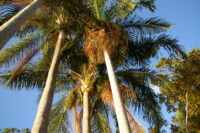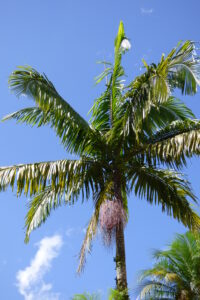Archontophoenix cunninghamiana, commonly known as the Piccabeen Palm, is a tall palm tree native to subtropical and tropical rainforests on the eastern coast of Australia.
With its straight trunk and graceful, arching fronds, it is highly valued for its elegant appearance.
Taxonomy:
- Family: Arecaceae
- Genus: Archontophoenix
Description:
- Growth: Grows up to 20-25 meters in height. Trunk is slender, smooth, and gray, with ringed leaf scars.
- Fronds: Dark green, pinnate, arching, and can reach up to 3-4 meters in length.
- Flowers: Small, white to pale lavender flowers that are arranged in large, branching clusters beneath the crown shaft.
- Fruit: Small, round drupe, bright red when ripe.
Habitat and Distribution:
Found in eastern Australia, from central New South Wales to southern Queensland. It thrives in rainforest environments, often along riverbanks and in moist, sheltered valleys.
Hosts: (included but not limited to)
- Rainbow Lorikeets (Trichoglossus moluccanus): Attracted to their nectar-rich flowers and small, red fruits. As they feed on the flowers’ nectar, they play a crucial role in pollination by transferring pollen between flowers.
- Figbirds (Sphecotheres viridis): Feeds on the fruits, aid in seed dispersal. Seeds are often excreted intact in their droppings, helping to establish new palm seedlings in suitable habitats away from the parent tree. This dispersal mechanism contributes to the regeneration and genetic diversity.
- Lewin’s Honeyeaters (Meliphaga lewinii): Consume fruits, contributes to seed dispersal dynamics and plays a part in maintaining the health and diversity of palm communities. Their movements between palm trees and across landscapes ensure genetic connectivity and resilience.
- Sugar Gliders (Petaurus breviceps): Utilize the palm’s dense foliage and trunk crevices for nesting, roosting, and shelter from predators.
- Green Tree Frog (Litoria caerulea): The vertical structure offered enhances habitat complexity and supports diverse assemblages of arboreal species, contributing to overall biodiversity and ecological resilience.
Ecology and Uses:
- Ornamental Landscaping: Widely cultivated as ornamental plants in gardens, parks, and urban landscapes across subtropical and tropical regions worldwide. Their graceful appearance, tall stature, and ability to thrive in various climatic conditions make them popular choices for adding tropical aesthetics to outdoor spaces.
- Erosion Control: Stabilize soil and prevent erosion in riparian zones and along watercourses. Their extensive root systems bind soil particles, reducing the risk of sediment runoff and soil erosion during heavy rainfall events. This function is crucial for maintaining water quality in adjacent water bodies and preserving the integrity of stream banks.
- Microclimate Regulation: The dense canopy provides shade and modifies microclimatic conditions beneath their foliage. This shading effect can moderate temperatures, reduce evaporation rates, and create microhabitats that support sensitive understory vegetation and wildlife species adapted to shaded environments.
Links:
Archontophoenix cunninghamiana : Bangalow Palm | Atlas of Living Australia (ala.org.au)




